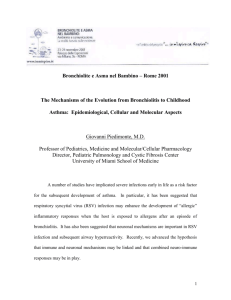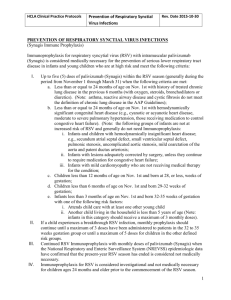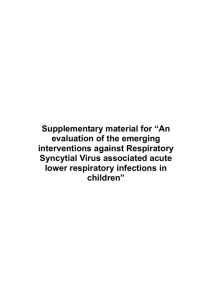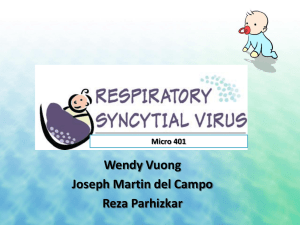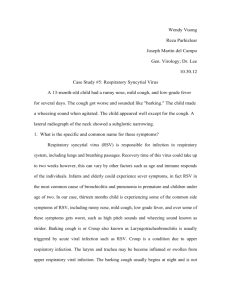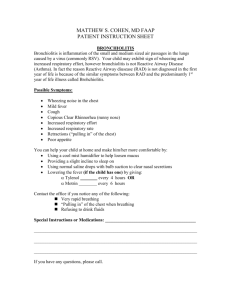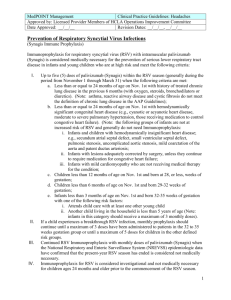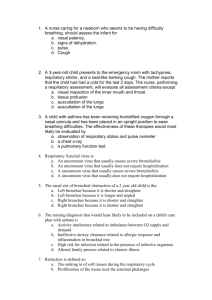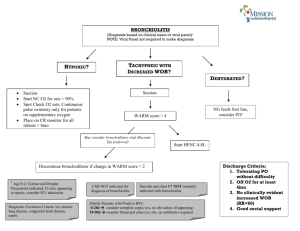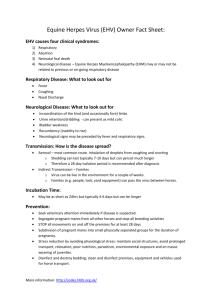Respiratory Syncytial Virus Bronchiolitis in Infants
advertisement
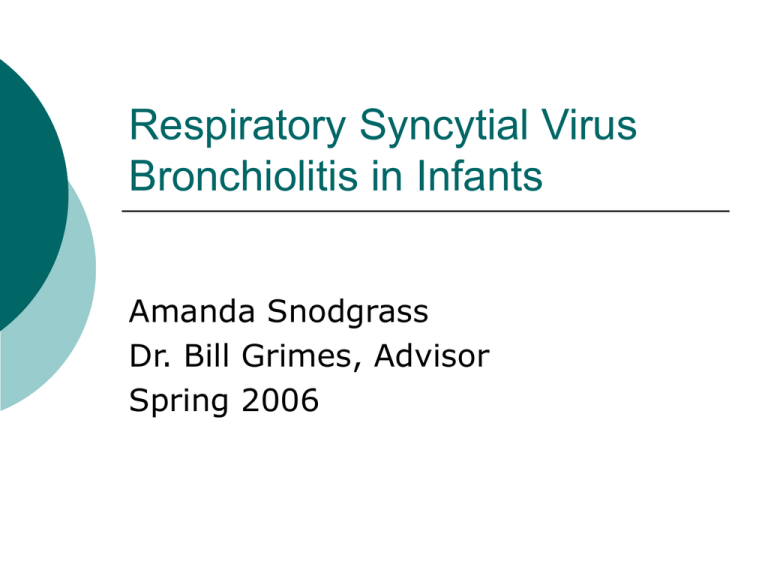
Respiratory Syncytial Virus Bronchiolitis in Infants Amanda Snodgrass Dr. Bill Grimes, Advisor Spring 2006 Objectives Mechanisms involved in RSV infection and severity Risk factors for severe RSV infection Prophylaxis and treatment of RSV Morbidity and Mortality Case Study RSV Facts Most common cause of bronchiolitis & pneumonia in children under 1 25-40% of children develop bronchiolitis or pneumonia during first RSV infection 31/1,000 under 1 yr. are hospitalized with RSV 2% will die Presentation Cold-like sx Audible wheezing SOB Anorexia Poor sleeping Irritability Vomiting Choking Pathophysiology Negative-strand RNA virus Family Paramyxoviridae RSV season late fall to early spring Peak in January/February Incubation 4-5 days, LRI between days 5-7 Severity of RSV Infection is Determined By: Inhibition of certain interferons Involvement of innate immune system Interleukins and chemokines Coinfection with other respiratory viruses Inhibition of Interferons Interferons believed to have antiviral properties NS1 & NS2 inhibit IFNalpha/beta Inhibition of IFN-gamma causes enhanced IgE production Innate Immune System Activation contributes to inflammation & injury RSV-F glycoprotein may inhibit T-cell activation RSV-infected CD8+ cells unable to release IFN-gamma Interleukins & Chemokines Infection induces expression Chemokines mimic RSV glycoproteins Recruit monocytes, eosinophils, & neutrophils IL-8 levels positively associated with severity Coinfection Rhinovirus contributes to increased severity in children with bronchiolitis Metapneumovirus (hMPV) enhances or mimics symptoms of RSV bronchiolitis 70% were coinfected w/ hMPV & required amission to PICU Risk Factors Premature Birth Likely to have chronic lung disease Hypersensitive to stimuli Underdeveloped airway & immunity Lack adult maternal levels of IgG CHD Are more often hospitalized Are more often admitted to PICU Are more likely to die Complications from pulmonary hypertension and increased hypoxia Environmental & Demographics Male infants Age & birth month of infant Crowding & day care attendance Secondhand smoke Factors NOT Positively Correlated Socioeconomic status Malnourishment Breastfeeding Prophylaxis RSV-IGIV (RespiGam) Children under 24 mo. w/ CHD or less than 35 wks. Gestation Given IV monthly during RSV season Volume overload possible Not for infants w/ hemodynamically significant heart disease. Prophylaxis Palivizumab (Synagis) Given IM monthly Can reduce hospitalization of high risk infants by 45% Expensive Many providers reluctant to give Many parents unaware Treatment Mostly symptomatic Salbutamol MDI drug of choice Also use epinephrine, ipratropium bromide, & oral steroids only if hospitalized Morbidity & Mortality More likely to visit a specialist More likely to use respiratory therapy More likely to receive diagnostic or therapeutic procedures More likely to be hospitalized again Subsequent hospitalization will be 3x as long Morbidity & Mortality More likely to suffer recurrent infections Many have recurrent acute otitis media Many likely to be hospitalized with another episode of acute respiratory distress Morbidity & Mortality Adolescents suffer from allergic asthma, allergic rhinoconjunctivitis, & more sensitive to inhaled allergens More likely to have asthma, bronchial reactivity to methacholine, and reduced lung function RSV ind. risk factor for reduced FEV% (FEV1/FVC) Follow Up References ALA (2004) Respiratory Syncytial Virus referenced online October 15, 2005 http://www.ala.org Braciale, Thomas J. (2005). Respiratory syncytial virus and T cells interplay between the virus and the host adaptive immune system. Proc Am Thorac Soc 2:141-146 Bradley, Joseph P., Bacharier, Leonard B., Bonfiglio, JoAnn, Schechtman, Kenneth B., Strunk, Robert, Storch, Gregory, Castro, Mario. (2005). Severity of respiratory syncytial virus bronchiolitis is affected by cigarette smoke exposure and atopy. Pediatrics 115;7-14 CDC. (2005). Respiratory Syncytial Virus referenced online October 15, 2005 http://www.cdc.gov Dakhama, Azzeddine, Park, Jung-Won, Taube, Christian, Chayama, Kosuke, Balhorn, Annette, Joetham, Anthony, Wei, Xu-Dong, et al. (2004). The role of virus-specific immunoglobulin E in airway hyperresponsiveness. Am J Respir Crit Care Med 170:952-959 Greensill, Julie, McNamara, Paul S., Dove, Winifred, Flanagan, Brian, Smyth, Rosalind L., Hart, Anthony. (2003). Human metapneumovirus in severe respiratory syncytial virus bronchiolitis. Emerging Infectious Diseases 9:3:372-375 Hoffman, Scott J., Laham, Federico R., Polack, Fernando P. (2004). Mechanisms of illness during respiratory syncytial virus infection: the lungs, the virus and the immune response. Microbes and Infection. 6:767-772 Kafetzis, D.A.; Astra, H.; Tsolia, M.; Liapi, G.; Mathioudakis, J.; Kallergi, K. (2003) Otitis and respiratory distress episodes following a respiratory syncytial virus infection. Clin Microbiol Infect 9:1006-1010 Korppi, Matti, Kotaniemi-Syrjanen, Anne, Waris, Matti, Vainionpaa, Raija, Reijonen, Tiina. (2004). Rhinovirus-associated wheezing in infancy comparison with respiratory syncytial virus bronchiolitis. The Pediatric Infectious Disease Journal 23:11;995-999 Korppi, M.; Piippo-Salvolainen, E.; Korhonen, K.; Remes, S. (2004) Respiratory morbidity 20 years after RSV infection in infancy. Pediatric Pulmonology 38:155-160 Meissner, H. Cody, Long, Sarah and the Committee on Infectious Diseases and Committee on Fetus and Newborn (2003). Revised indications for the use of palivizumab and respiratory syncytial virus immune globulin intravenous for the prevention of respiratory syncytial virus infections. Pediatrics 112:6;1447-1452 Moynihon, James; Kim, Tommy; Young, Tammy; Checchia, Paul (2004) Rate of palivizumab administration in accordance with current recommendations among hospitalized children. Journal of Pediatric Health Care 18:224-227 Plint, Amy; Johnson, David; Wiebe, Natasha; Bulloch, Blake; Pusic, Martin; Joubert, Gary; Pianosi, Paul; Turner, Troy; Thompson, Graham; Klassen, Terry. (2004) Practice variation among pediatric emergency departments in the treatment of bronchiolitis. Acad Emerg Med 11;4:353-360 Sampalis, John (2003) Morbidity and mortality after RSV-associated hospitalizations among premature Canadian infants. Journal of Pediatrics 143:S150-S156 Sigurs, Nele; Gustaffson, M.; Bjarnason, Ragnar; Lundberg, Fredrik; Schmidt, Susanne; Sigurbergsson, Fredrik; Kjellman, Bengt. (2005) Severe respiratory syncytial virus bronchiolitis in infancy and asthma and allergy at age 13. Am J Respir Crit Care Med 171:137-141 Smoes, Eric (2003) Environmental and demographic risk factors for respiratory syncytial virus lower respiratory tract disease. Journal of Pediatrics 143:S118-S126 Stevens, Timothy, Hall, Caroline. (2004). Controversies in palivizumab use. The Pediatric Infectious Disease Journal 23:11;10511052 Welliver, Robert C. (2003). Review of epidemiology and clinical risk factors for severe respiratory syncytial virus (RSV) infection. J Pediatr 143:S112-S117
